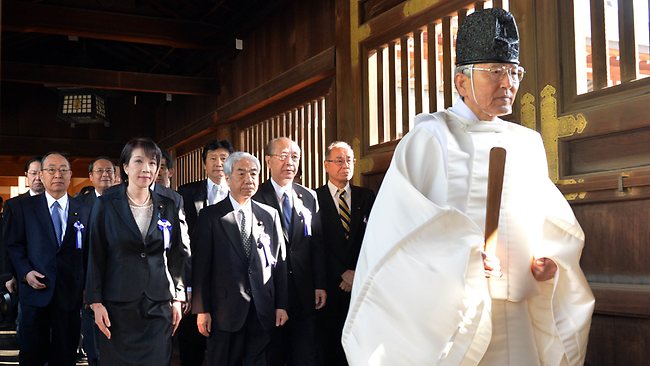Last autumn the Norwegian Nobel Committee surprised the world by awarding its Peace Prize to the EU. At a time when the Euro crisis was igniting tensions between northern and southern Europe, it seemed an eccentric decision.
Japan would have been a better choice as an example of transformation from warrior to model global citizen. Article 9 of the Japanese constitution renounces the “right of belligerency of the state” and Japan’s military forces have not fired a shot in anger since 1945.
Japan has three festering disputes with its neighbours. The first concerns islands north of Hokkaido, once part of Imperial Japan but now controlled by Russia. The future of these Northern Territories will have been a key issue in Prime Minister Abe’s recent trip to Russia. The second bone of contention is the tiny island of Takeshima (Tokto in Korean), claimed by Japan but controlled by South Korea.
The third and most potentially explosive dispute relates to the cluster of islets in the East China Sea known as Senkaku in Japanese and Diaoyu in Chinese. The only humans who have settled these storm-battered rocks are Japanese albatross farmers before the war. Now that China is building a blue-water navy, they have become strategically significant.
As with most such quarrels, there are plausible arguments on all sides. The crucial distinction is how the points are made. In Japan, there have been no riots, no export embargos, no gunboat diplomacy. Instead Japan has patiently pursued its claims through the conventional process. In the case of the Northern Territories, that stretches back to the Gromyko Statement of 1960.
This is the context in which the brouhaha kicked up about the recent visits of Japanese politicians to Yasukuni Shrine should be viewed.
Yasukuni is complex. It is both a war memorial like the Cenotaph and a symbol of the authoritarian state that ruled Japan from 1868 to 1945 and the emperor-worship that underpinned it.
All who died in the service of the emperor are memorialized there, including non-Japanese such as the brother of Taiwan’s ex-President Lee Teng-hui. Japanese nationals who fought against the state are excluded. That means, for example, no place for the samurai army led by Japanese hero Saigo Takamori in the rebellion of 1877.*
Over the New Year festivities, the shrine becomes a fun place to visit. The grounds overflow with people praying for good fortune, enjoying roast squid and chocolate bananas and viewing lion dances. The quantum of aggressive nationalism in the air is zero. 
Close-by, however, stands the War Museum, which presents a sometimes revisionist take on Japan’s disastrous late charge into the Age of Empire.
Japan is hardly unique in struggling to address the darker episodes of its history. Re-engineering the past to match the needs of the present is the norm rather than exception. The older powers do it with more style – witness the architectural and musical paeans to Napoleon’s bloody rampage through Europe.
But the idea that visits to Yasukuni presage a return to the values of the 1930s is wide of the mark. Japanese leaders have been paying their respects at the shrine since the days of Shigeru Yoshida, originator of the pragmatic Yoshida doctrine that has dominated Japanese politics for sixty years. Respected figures like ex-prime ministers Junichiro Koizumi and Yasuhiro Nakasone followed suit. Japan has remained pacifist throughout this period, with military spending capped at a Belgium-like 1% of GDP.
The diplomatic ritual of denunciations by China and the two Koreas began in the mid-1980s, after it became public that 14 Class A war criminals had been added to the roster of the dead (there are no physical remains or memorial tablets at Yasukuni).
“Class A” sounds as if it signifies the highest grade of heinousness, but in fact these men were politicians and diplomats convicted of the political crime of waging aggressive war – an offence that many famous world figures, past and present, could be accused of committing. The Class B and C war criminals, the ones who actually committed atrocities, had been enshrined from the start.
Ultimately how Yasukuni is “read” – or which reading becomes dominant – can only be decided by the current and future generations of Japanese
If Japan does move away from its post-war pacifism, it will be not because it has been taken over by a cabal of back-to-the-thirties rightists, but because geopolitical circumstances have changed. It is no surprise that Prime Minister Abe won his electoral landslide just months after the Senkaku/Diaoyu dispute erupted.
In the Japanese political context, Mr. Abe is a hawk – though that doesn’t mean he favours bombing or occupying foreign countries. He came to prominence by campaigning for abductees snatched from Japanese soil by North Korean agents.
Revision of Japan’s US-conceived constitution is on his medium-term agenda. That could be a healthy development, if it generates greater debate about the way Japan is governed. Let’s hope the final product has more democratic legitimacy than the European Constitution, which died at the ballot-box but then came back to life as an inter-governmental treaty.
If Mr. Abe scores further electoral successes by combining appeals to national pride with a regime shift in monetary policy, he will merely be copying the playbook of a celebrated political leader who passed away recently.
Optimism, confidence and assertiveness go together. If Abenomics works, we can expect quite a bit more of them.
* In 1965 the Chinreisha, a much smaller shrine set apart from the main building, was set up to commemorate other victims of war. That includes not just Saigo’s men, but also the foreign war dead, civilians killed in the atom bombings and fire bombing of Tokyo, as well as horses, dogs and other creatures used in battle.
